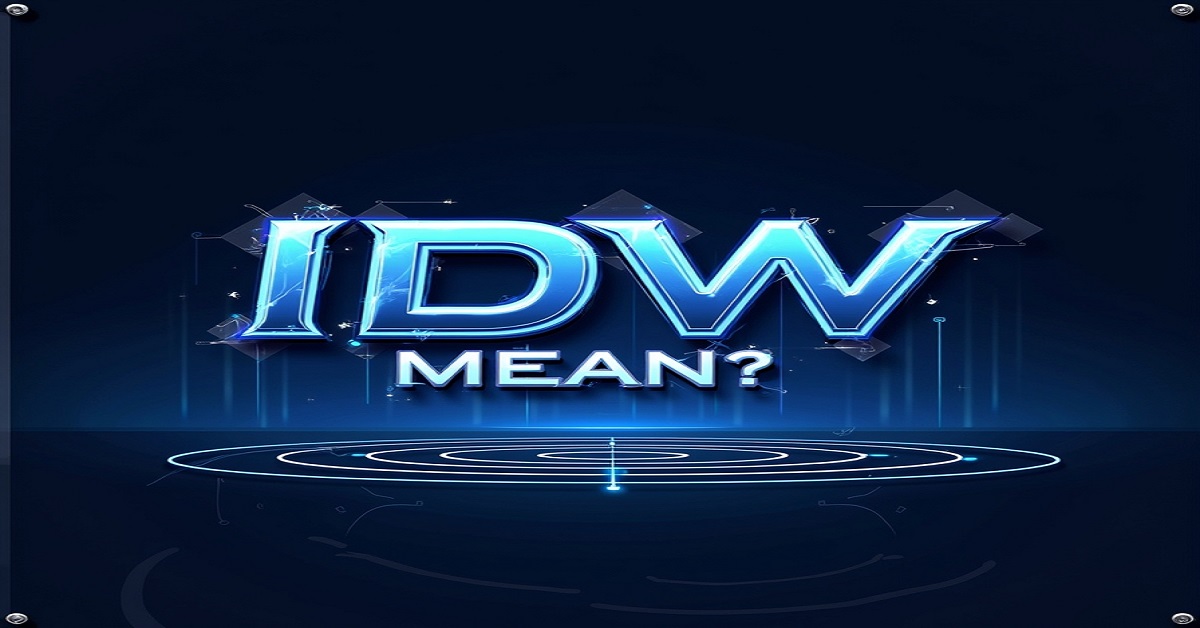Ever found yourself caught in a conversation where everyone’s throwing around abbreviations like confetti at a New Year’s Eve party? And there you are, nodding along, pretending you understand what “IDW” means while secretly Googling it on the side? Don’t worry, we’ve all been there. But today, I’m going to decode one of these perplexing pieces of slang—IDW—so you can confidently drop it into a conversation without looking like you just stepped out of a time machine.
So, grab a snack (or don’t, I know, IDW about that) and let’s dive into what IDW really means and why it’s become a staple in youth communication.
What Does IDW Mean?
Alright, let’s start with the basics. IDW stands for “I Don’t Want.” Simple, right? But in the world of texting and online chats, this abbreviation is like a quiet yet firm way of saying, “Nah, I’m good,” without using the full sentence. It’s a low-effort way to express a lack of interest or enthusiasm for whatever’s being proposed. Whether it’s a suggestion to hang out, try a new food, or watch a movie that everyone is hyped about (but you really couldn’t care less), IDW gets the job done with just three letters.
So, the next time someone proposes a game night that doesn’t appeal to you, you can just shoot back an “IDW” and save yourself the trouble of typing a whole sentence. Efficiency at its finest!
The Beauty of IDW: Short and Sweet
One of the best things about IDW is its brevity. In a world where every second counts, especially in the fast-paced realm of texting, this tiny abbreviation saves you time and keeps the conversation flowing without much effort. You don’t need to come up with a clever excuse or a long-winded explanation. “I Don’t Want” could be a sentence, but in the world of texting, it’s reduced to an acronym that’s as quick as a blink.
How Is IDW Used in Real Life?
Let’s paint a picture, shall we? Imagine you’re in a group chat with your friends, and someone suggests, “Let’s go to that new sushi restaurant this weekend!” Now, you’re not in the mood for sushi. You’d rather binge-watch a series or maybe just nap. What do you do?
Instead of typing out a whole paragraph about why sushi isn’t your thing (which, let’s be real, can be exhausting), you simply text “IDW” and let the power of abbreviation take care of the rest. Your friends will get it—you’re not interested. It’s polite, efficient, and leaves no room for misinterpretation.
Scenario 1: The Movie Night Dilemma
Friend 1: “Yo, movie night at my place! Who’s in?”
You: “IDW. I’m more in the mood for a solo Netflix binge.”
Boom. You’ve declined the offer with minimal effort. You don’t have to explain why you’re not into their movie choice or why you’d rather not socialize. IDW does it for you, my friend.
Scenario 2: The Food Dilemma
Friend: “We’re getting Thai food for lunch today, you in?”
You: “IDW. I’m still recovering from my burger overload yesterday.”
Once again, you’ve managed to convey your disinterest without having to dive into your digestive issues. IDW saves the day.
Why Do People Use IDW?
You might be wondering, “Why even bother with an acronym like this?” Well, using slang like IDW serves a few purposes in modern communication. Let’s break it down.
1. Efficiency Over Everything
Let’s face it: no one has time to write out long sentences when you could just use an acronym. In an age where we’re bombarded with notifications and messages, brevity is king. IDW allows you to communicate your feelings quickly and without unnecessary fluff. It’s like the fast food of language—grab it, say what you need to say, and move on.
2. The Cool Factor
There’s something undeniably cool about using shorthand. It’s like you’re part of an exclusive club that knows all the latest abbreviations and can toss them into conversations like seasoned pros. Using IDW, especially if you’re in a group of friends who use it regularly, can make you sound “in-the-know” and help you avoid being labeled as “out of touch.”
3. A Little Bit of Humor
Sometimes, IDW isn’t just about disinterest—it can be used as a playful way to reject something while still keeping the mood light. Imagine a friend excitedly suggesting a trip to a theme park, and you respond with “IDW” because you’d rather stay home in your pajamas. The response is both funny and clear. It’s like saying, “No thanks, but I’m not mad about it either.” It adds a bit of humor and relatability to the conversation.
Common Questions About IDW
You’re probably still wondering, “Is it just me, or are there more questions floating around about this than I thought?” Well, you’re in luck! Let’s tackle some of the most frequently asked questions about IDW to clear up any lingering confusion.
Is IDW Only Used by Young People?
Not at all! While it’s true that abbreviations like IDW are more common in younger crowds (hello, Gen Z and millennials), people of all ages use shorthand to make communication faster and more efficient. You might catch your parents or even grandparents using “IDW” once they get the hang of it. So, don’t be surprised if you hear it from someone who’s technically old enough to be your parent.
Can IDW Be Used for Everything?
In a word: no. IDW works best for situations where you’re politely rejecting or expressing a lack of interest. It’s not really suitable for serious conversations or times when you need to explain something in depth. But, in casual conversations with friends or family, it’s a pretty handy tool.
How Do I Respond if Someone Says IDW?
If someone hits you with an “IDW,” don’t take it personally. It’s just their way of saying they’re not interested in whatever you’re suggesting. You can always try to suggest something else, or just let it be. People use IDW in a lighthearted way, so there’s no need to get upset.
Using IDW with Other Slang
IDW isn’t the only abbreviation in town, my friend. It’s just one piece of the puzzle in the ever-growing world of internet slang. For instance, you might encounter “NVM” (Never Mind), “SMH” (Shaking My Head), or “BRB” (Be Right Back). When combined, these acronyms can make a conversation flow like a fast-moving river. Just remember, it’s all about context. Use them when they fit the vibe, and don’t force them into every sentence.
For example, after someone responds to your suggestion with “IDW,” you could reply with “SMH” to express your disbelief in a playful way. Or, if you change your mind later, hit them with “NVM” to let them know you’re back in.
To IDW or Not to IDW?
Now, you might be wondering whether you should use IDW all the time. The answer is—it depends. In some situations, you might want to be more polite and offer an explanation. But if you’re texting your friends or chatting online in a casual setting, IDW can be a perfect, breezy way to communicate your disinterest without overthinking it.
The Bottom Line
IDW is one of those small-but-mighty abbreviations that has found a special place in modern communication. It’s fast, it’s casual, and it’s perfect for telling someone, “I’m good, thanks,” without getting bogged down in lengthy responses. Plus, it’s a great way to keep things light and fun. So, next time you’re texting someone and you’re just not feeling it, toss in an IDW and carry on with your day. You’ll be a communication pro in no time.
Now, I want to hear from you. How do you feel about slang abbreviations like IDW? Do you use them, or are you more of a “full-sentence” person? Share your thoughts below—I’m curious to know!
FAQs About IDW Slang
1. What does IDW stand for?
IDW stands for “I Don’t Want.” It’s an abbreviation used to express disinterest or a lack of enthusiasm for something, typically in response to a suggestion or invitation.
2. When should I use IDW?
You should use IDW when you want to politely reject an idea or suggestion without getting into a long explanation. It’s perfect for casual conversations where brevity and lightheartedness are key.
3. Is IDW only used by young people?
While IDW is popular among younger generations like Gen Z and millennials, people of all ages can use it. It’s part of the growing trend of shorthand language used to keep communication quick and casual.
4. Can I use IDW in serious conversations?
Not really. IDW is best for lighthearted, casual conversations. It’s not ideal for situations where you need to explain something in depth or express more serious emotions.
5. How do I respond if someone uses IDW?
If someone responds with IDW, it simply means they’re not interested in what you’re suggesting. There’s no need to take offense. You can suggest something else or just move on to another topic. It’s all in good fun!
6. Are there other slang abbreviations like IDW?
Yes, there are plenty! Some common ones include:
- NVM (Never Mind)
- SMH (Shaking My Head)
- BRB (Be Right Back) Using these in combination can make your conversations more efficient and even funnier, depending on the context.
7. Can IDW be used in a professional setting?
It’s generally best to avoid using IDW in professional or formal conversations. It’s an informal slang term suited for texting or chatting with friends, not for work emails or business discussions.
8. Why is IDW so popular in texting?
IDW is popular because it’s short, efficient, and quick to type. In the fast-paced world of texting and online messaging, people love shorthand phrases that save time while still conveying their message clearly.
9. What if I don’t want to seem rude when using IDW?
Don’t worry! IDW is usually used in a playful, lighthearted way, so it doesn’t come across as rude. If you’re concerned, you can always soften it by adding an emoji or following it up with a brief, humorous explanation.

Tony James is a passionate wordsmith and the creative force behind Winky Hive. With a knack for uncovering the stories behind slang and weaving emotions into poetry, Tony brings a unique voice to every piece he writes. A lifelong lover of language, he thrives on exploring how words evolve, connect, and inspire.
When he’s not penning articles or crafting verses, Tony enjoys diving into cultural trends, reading classic poetry, and discovering hidden gems in modern expressions. His mission? To make Winky Hive a haven for those who love the art of language in all its vibrant forms.









